HOPE Meetings with Nobel Laureates
16th HOPE Meeting
Report of the 16th HOPE Meeting
Date: Sunday, 9 March through Thursday, 13 March 2025
*HOPE Meeting participants attended Nobel Prize Dialogue Tokyo 2025 (external site) on Sunday, 9 March
Venue: Conference Center, PACIFICO Yokohama (Yokohama-city, Kanagawa)
Subject Fields: Physics, Chemistry, Physiology/Medicine and Related Fields
Organizer: Japan Society for the Promotion of Science (JSPS)
*HOPE Meeting participants attended Nobel Prize Dialogue Tokyo 2025 (external site) on Sunday, 9 March
Venue: Conference Center, PACIFICO Yokohama (Yokohama-city, Kanagawa)
Subject Fields: Physics, Chemistry, Physiology/Medicine and Related Fields
Organizer: Japan Society for the Promotion of Science (JSPS)

The 16th HOPE Meeting was attended by 100 doctoral students and young researchers from 20 participating Asia-Pacific and African countries and regions.
Japan, Australia, Bangladesh, China, India, Indonesia, Israel, Kenya, Korea, Malaysia, Myanmar, Nepal, New Zealand, Philippines, Senegal, Singapore, South Africa, Taiwan, Thailand, Turkey
Japan, Australia, Bangladesh, China, India, Indonesia, Israel, Kenya, Korea, Malaysia, Myanmar, Nepal, New Zealand, Philippines, Senegal, Singapore, South Africa, Taiwan, Thailand, Turkey
The HOPE Meeting participants attended the Nobel Prize Dialogue Tokyo 2025 (external site) on Sunday, March 9, held at PACIFICO Yokohama. Blessed with clear skies, the event attracted an audience of approximately 900 people, who shared their thoughts on the theme “The Future of Life,” addressed via a program of lectures and panel discussions. During the Q&A session, the HOPE Meeting participants actively engaged in asking questions.
After the event, the participants attended a reception where they had an opportunity to meet in person the Dialogue’s Nobel Laureates and other distinguished panelists.
After the event, the participants attended a reception where they had an opportunity to meet in person the Dialogue’s Nobel Laureates and other distinguished panelists.
The 16th HOPE Meeting kicked off on Monday, March 10. Dr. KAJITA Takaaki, Chair of the Organizing Committee, gave opening remarks and JSPS President SUGINO Tsuyoshi offered remarks on behalf of the organizer. Then, each Organizing Committee member gave a one-minute self-introduction. The ceremony ended with everyone taking a commemorative photograph.
Six Nobel Laureates, two from each of the three fields of natural science addressed, participated as lecturers in this year's HOPE Meeting. Young and mid-career Japanese researchers in research fields close to those of the lecturers served as moderators, acting as “bridges” between the participants and the distinguished lecturers. The moderators gave one-minute self-introductions using the same format as the participants during the Flash Talk sessions.
KAJITA Takaaki
Nobel Laureate in Physics 2015
Brian P. SCHMIDT
Nobel Laureate in Physics 2011
Bernard L. FERINGA
Nobel Laureate in Chemistry 2016
Ada YONATH
Nobel Laureate in Chemistry 2009
Svante PÄÄBO
Nobel Laureate in Physiology or Medicine 2022
Andrew Zachary FIRE
Nobel Laureate in Physiology or Medicine 2006
Lectures by Nobel Laureates
During the sessions, each of the six Nobel Laureates gave a one-hour lecture (45-minute talk and 15-minute Q&A). Taking advantage of this opportunity, the young researchers asked these global science leaders volleys of questions.

Dr. Pääbo lecturing
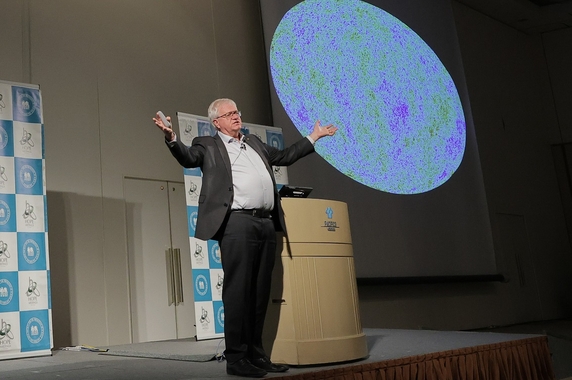
Dr. Schmidt lecturing
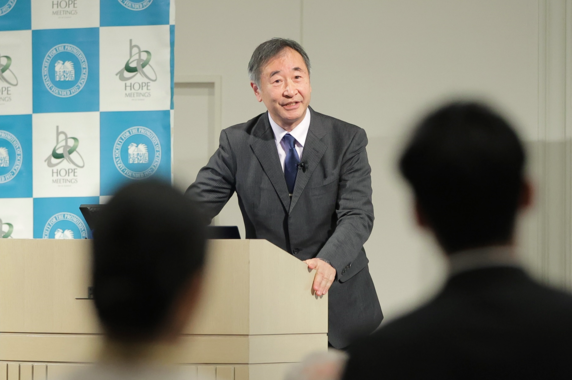
Dr. Kajita in a Q&A Session
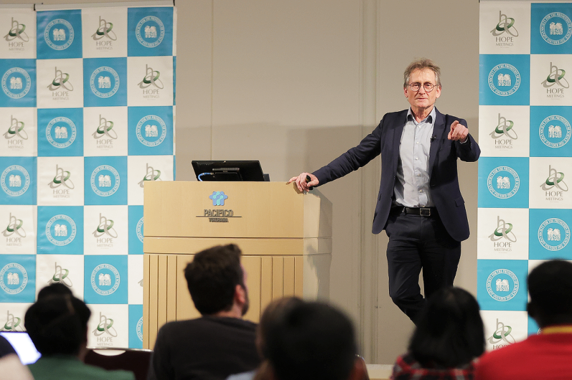
Dr. Feringa in a Q&A Session
Group Discussions with Nobel Laureates
45-minute group discussions were also held with about 20 young researchers surrounding one Nobel Laureate in them. The participants rotated so as to attend group discussions with three Nobel Laureates. Held in a small and friendly atmosphere, the discussions gave the participants an opportunity to deepen their specialized knowledge through talks with the Nobel Laureates about their research and to be inspired by their messages.
New to this year's HOPE Meeting were discussion sessions led by three groups of two HOPE Meeting alumni/alumnae (six in total) during this group discussion time. They exchanged views on issues facing young researchers, such as career paths and work-life balance.
New to this year's HOPE Meeting were discussion sessions led by three groups of two HOPE Meeting alumni/alumnae (six in total) during this group discussion time. They exchanged views on issues facing young researchers, such as career paths and work-life balance.
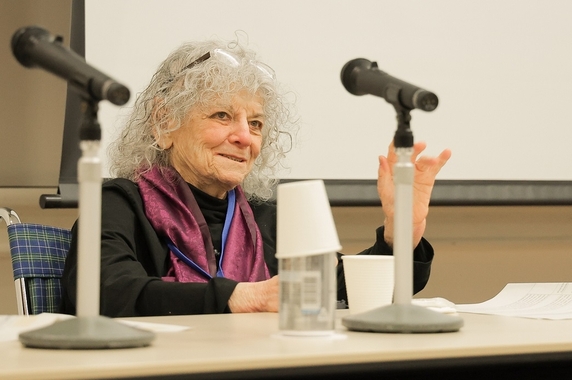
Dr. Yonath in a group discussion

Dr. Fire in a group discussion
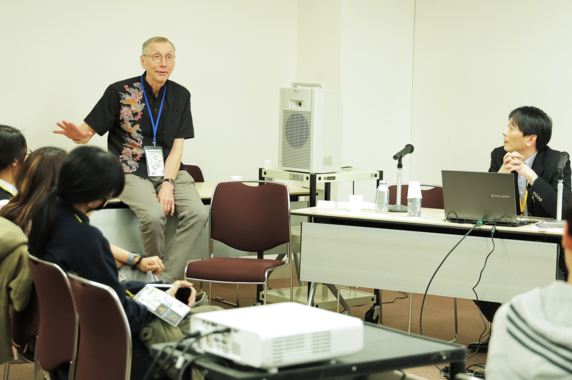
Dr. Pääbo in a group discussion
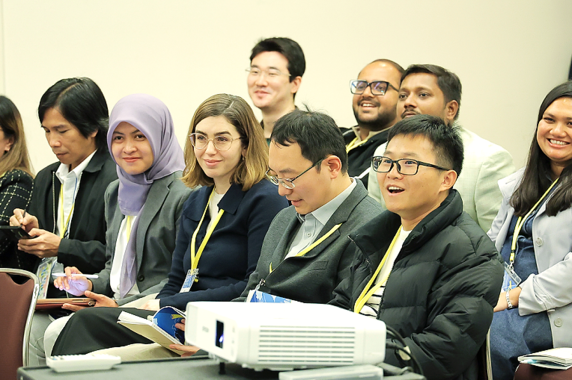
Participants in a group discussion
The participants were assigned roles in two activities: a “poster presentation” in which they presented their research as individual researchers, and “team presentations,” held on the last day, in which they gave presentations crafted in collaboration with multicultural and multidisciplinary teammates.
Presenting participants’ Own Research ―― Flash Talks and Poster Sessions
Posters outlining the participants' research were displayed in the foyer over the course of the HOPE Meeting. On their assigned day, the participants first gave a one-minute “Flash Talk,” summarizing their research, and then described their research standing in front of their posters. Enthusiastically, the young participants explained their research. Their audiences listened intently and asked probing questions.
All attendees, including lecturers, Organizing Committee members, and moderators, cast one vote each day for the poster-award selection. Based on the results of the voting, the Organizing Committee conducted a collegial review and selected the poster award winners. The “Best Poster Presentation Award” was presented to the six best poster presenters, and the “Chairperson's Award (HOPE Award)” was given to one of the Best Poster Award winners.
Chairperson's Award (HOPE Award)
OKUI Haruka (University of Bath)
Best Poster Award
- Yuanjing LIN (Southern University of Science and Technology)
- Kang XIA (The University of Tokyo)
- KIYAMA Hana (Osaka Metropolitan University)
- OKUI Haruka (University of Bath)
- Younsoo BYUN (Dankook University)
- Pattaraporn PANRAKSA (Chiang Mai University)
All attendees, including lecturers, Organizing Committee members, and moderators, cast one vote each day for the poster-award selection. Based on the results of the voting, the Organizing Committee conducted a collegial review and selected the poster award winners. The “Best Poster Presentation Award” was presented to the six best poster presenters, and the “Chairperson's Award (HOPE Award)” was given to one of the Best Poster Award winners.
Chairperson's Award (HOPE Award)
OKUI Haruka (University of Bath)
Best Poster Award
- Yuanjing LIN (Southern University of Science and Technology)
- Kang XIA (The University of Tokyo)
- KIYAMA Hana (Osaka Metropolitan University)
- OKUI Haruka (University of Bath)
- Younsoo BYUN (Dankook University)
- Pattaraporn PANRAKSA (Chiang Mai University)
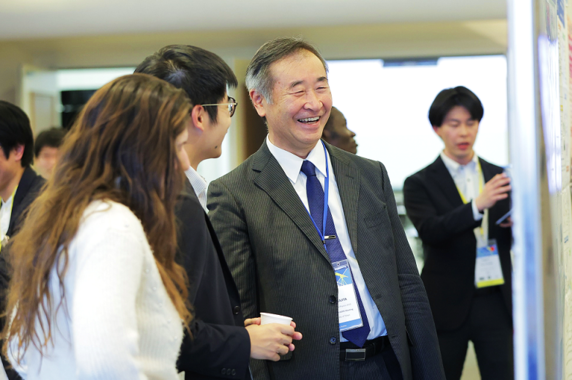
Dr. Kajita at a Poster Session
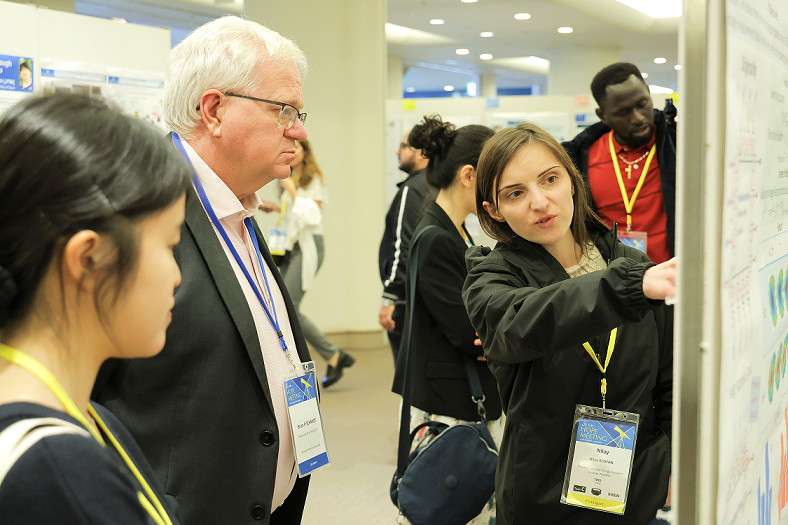
Dr. Schmidt at a Poster Session

Dr. Feringa at a Poster Session
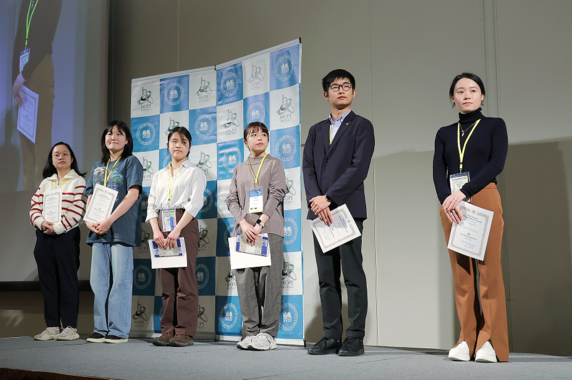
Winners of the "Best Poster Presentation Award"
Creating Presentations with Peers ―― Team Presentations
The 100 participants were assigned by the secretariat to 10 teams, titled Team A to Team J. Within a limited timeframe, teammates of different cultural backgrounds and research fields worked together to create presentations on how they, as scientists, could contribute to solving common societal problems, such as achieving SDGs (Sustainable Development Goals). The presentations were delivered on the final day on the meeting.
In the closing ceremony, two types of awards (Unique and Best) were presented to the two winning teams by Dr. KAJITA, chosen based on the results of voting by all the participants.
In the closing ceremony, two types of awards (Unique and Best) were presented to the two winning teams by Dr. KAJITA, chosen based on the results of voting by all the participants.
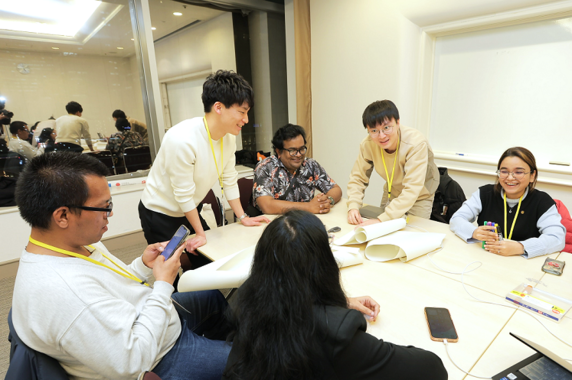
Participants working in teams on assignments
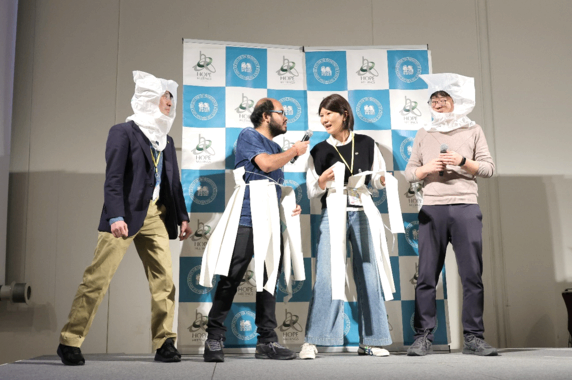
Team Presentation
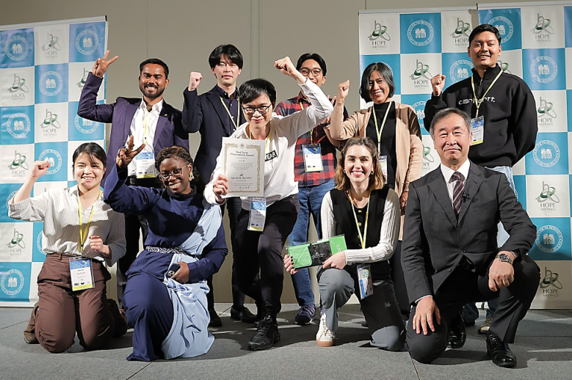
Winner of the "Best Team Presentation Award" (Team G)
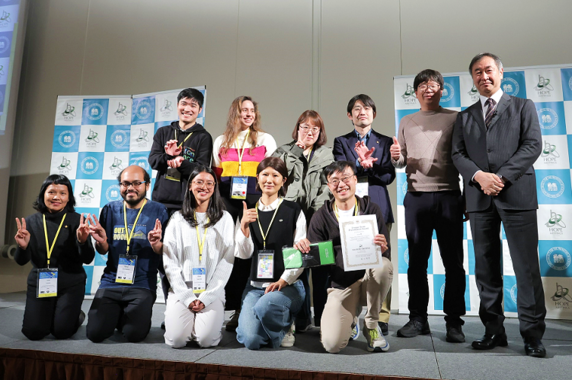
Winner of the "Unique Team Presentation Award" (Team B)
So as to incorporate pulsating activities into the HOPE Meeting program in lieu of just passive lecture listening and to raise awareness among the young researchers in the ethical aspects they may face in conducting their research activities, a “Research Ethics Workshop” was held for the first time. Professor NAKAMURA Masaki of Osaka University was invited to give the lecture. The workshop was conducted using the Dilemma Game (external site) developed by the Erasmus University Rotterdam in the Netherlands. Divided into small groups, the participants enthusiastically engaged each other in playing their game roles.
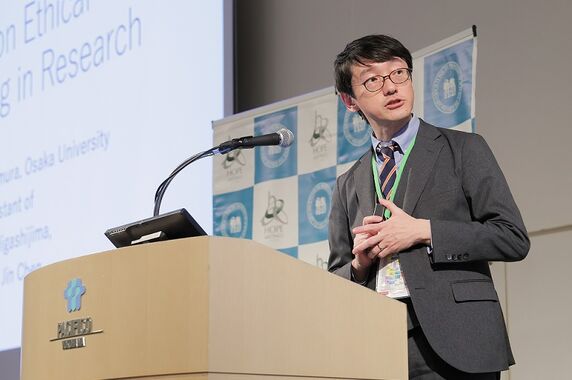
Dr. Nakamura at the Research Ethics Workshop
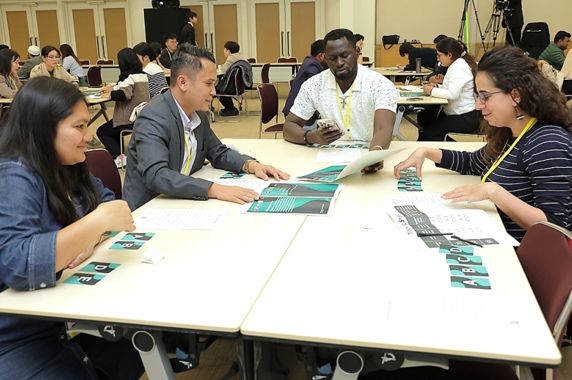
Research Ethics Workshop
Young researchers from the participating countries and regions visited Japanese research institutions.
Divided into three groups, they visited RIKEN Yokohama Campus (external site), WPI-ELSI at Institute of Science Tokyo (external site), and WPI-Bio2Q at Keio University (external site), where they listened to explanations from researchers and toured research facilities and laboratories.
To introduce research activities and opportunities in Japan, JSPS’s staff described the JSPS Fellowship Program for Overseas Researchers during the group discussion and lunch periods. Pathways for young researchers from other countries to pursue their research as JSPS Fellows in Japan and backup systems for the Fellows were explained. Japan’s flagship World Premier International Research Center Initiative (WPI) program was also introduced.
Divided into three groups, they visited RIKEN Yokohama Campus (external site), WPI-ELSI at Institute of Science Tokyo (external site), and WPI-Bio2Q at Keio University (external site), where they listened to explanations from researchers and toured research facilities and laboratories.
To introduce research activities and opportunities in Japan, JSPS’s staff described the JSPS Fellowship Program for Overseas Researchers during the group discussion and lunch periods. Pathways for young researchers from other countries to pursue their research as JSPS Fellows in Japan and backup systems for the Fellows were explained. Japan’s flagship World Premier International Research Center Initiative (WPI) program was also introduced.
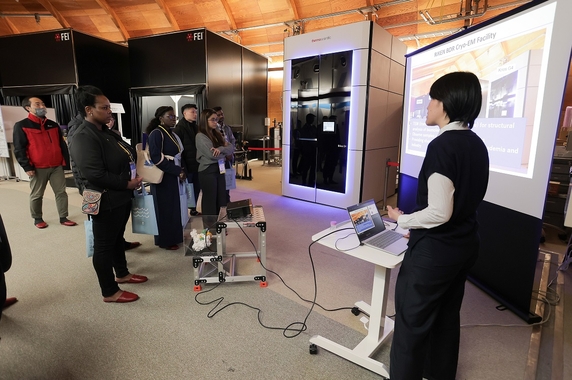
RIKEN Yokohama Campus

WPI-ELSI at Institute of Science Tokyo (Credit: ELSI)
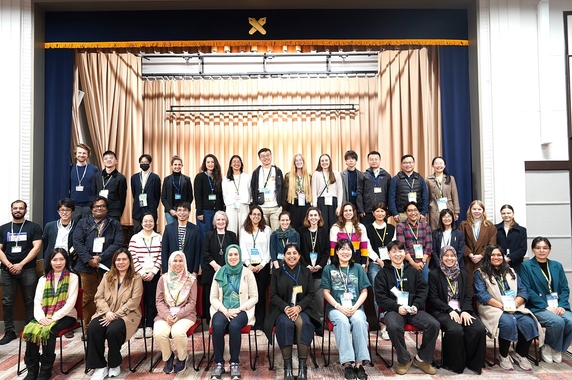
WPI-Bio2Q at Keio University (Photo by Bio2Q)
Programs to give the participants opportunities to experience Japanese culture were also held during the HOPE Meeting. They watched a Tsugaru Shamisen (3-string) performance, after which the participants were divided into two programs based on whether they wished to participate in a tea ceremony or kimono dressing. These activities gave them the chance to actually experienced traditional Japanese culture both with their hands and bodies. During the shamisen concert, some of the participants joined in dancing the Soranbushi in front of everyone and had a great time.
On the last day, the participants went on an excursion to Asakusa (浅草), where they enjoyed rich cultural surroundings including the Senso-ji Buddhist Temple and the traditional Nakamise shopping street. Moving to Yokohama, they enjoyed night views of the Port of Yokohama from the Yokohama Marine Tower where their farewell dinner was held.
On the last day, the participants went on an excursion to Asakusa (浅草), where they enjoyed rich cultural surroundings including the Senso-ji Buddhist Temple and the traditional Nakamise shopping street. Moving to Yokohama, they enjoyed night views of the Port of Yokohama from the Yokohama Marine Tower where their farewell dinner was held.
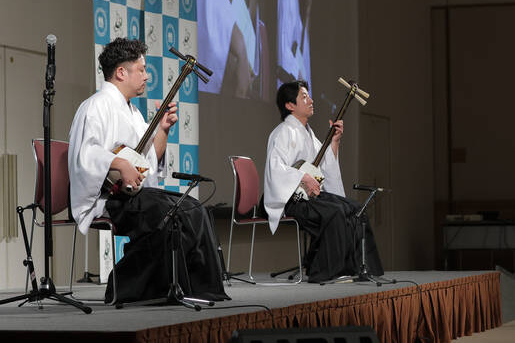
Tsugaru Shamisen performance

Japanese culture experience(tea ceremony)
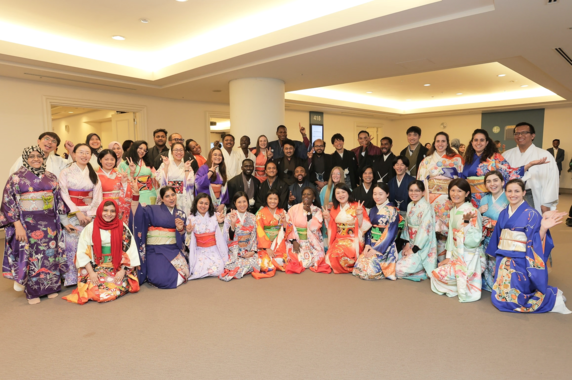
Japanese culture experience(kimono dressing)
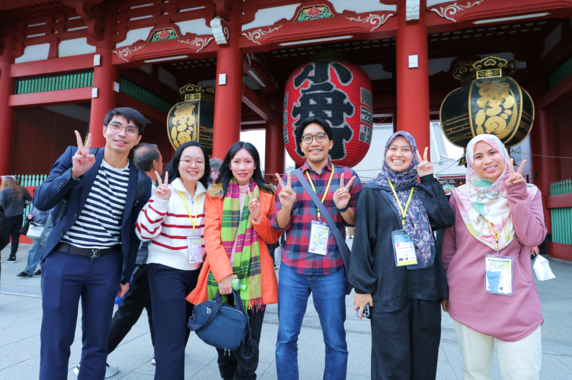
Excursion (Sensoーji)

